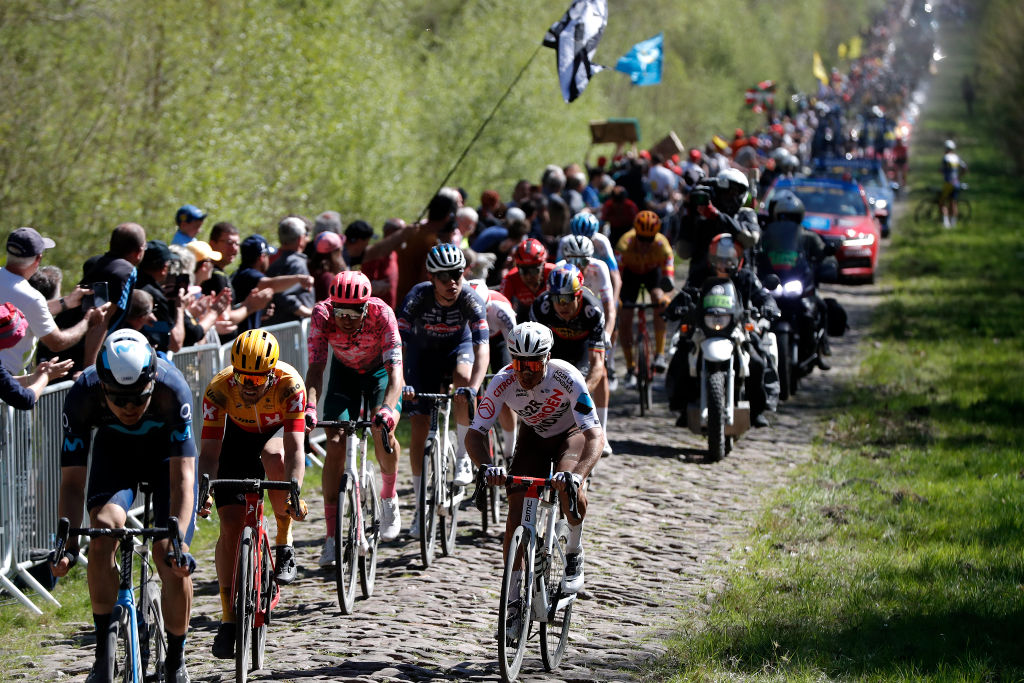Paris-Roubaix: the key cobbled sectors
We look at some of the most famous and most significant sectors of pavé in the Hell of the North


Without its pavé, the Queen of the Classics would be no such thing. It would be relegated to the post of court jester – a slightly rolling jaunt across the fields of northern France that would be no more than a very long wait for a bunch sprint in the velodrome (which in fairness would be a sight to see).
Its cobbled tracks – relics of a bygone era – bring the spectacle, the entertainment and the character to the race. In the dry sunny weather they're dusty, tricky and slippery, and of course in the wet they are the same but with mud not dust. Each year the winner, in a final act of physical exertion, hikes a huge cobblestone trophy above his or her head.
Each year there are anything up to 30 sectors in the men's race, with the women's races featuring 17. They come and go, and some are less daunting than others, but they're all a challenge. Let's take a look at some of the most iconic.
Carrefour de l'Abre
Length: 2,085m | Sector: 4 | Stars: 5
Translated as 'crossroad of the tree', the Carrefour is one of the most iconic and even romantic of the Roubaix sectors. It twists and turns away from the tiny village of Camphin-en-Pevèle, before straightening out, traversing open farmland to ultimately reach what is indeed tree-specked crossroads. Completing the scene is the restaurant L'Abre, solitary building that has stood in place for decades and can be seen in old black and white pictures of the race. The cobbles themselves are fiendish – not quite as uniformly terrible as those at Arenberg but not far off. The challenge it presents with just 15km remaining makes it a favourite launch pad for the race's eventual winner.

The men's race takes on Arenberg in 2022
Trouée d'Arenberg
Length: 2,300m | Sector: 19 | Stars: 5
This dark and forbidding road through the Forest of Arenberg describes a die-straight line between the trees and features the worst cobbles in the race – like a long row of granite half-bricks has been dumped off the back of a truck. There are peaks, troughs and holes, and they're slow to dry after rain thanks to the dank and murky forest microclimate. The riders hit Arenberg after around 160km (100 miles), but this is where the race really begins. When it exits the forest 2.3km later, it has become a more haggard, fragmented version of its former self, and for many, any hope of victory has gone.
Get The Leadout Newsletter
The latest race content, interviews, features, reviews and expert buying guides, direct to your inbox!
Mons-en-Pevèle
Length: 3,000m | Sector 11 | Stars 5
One of the longest sectors in the race also gets the five-star treatment. Coming shortly after the 200km mark and immediately preceded by th 2.7km Auchy-Bersée sector, Mons-en-Pevele greets the riders near the sharp end of the race: battered, tired, but still with much to do. The sector zig-zags east to west across open farmland, opening slightly downhill, bumping through tight bends. With the last 500m slightly uphill, it's a good spot to drive home an advantage or even make a move – as Fabian Cancellara showed in 2010.
Troisvilles
Length: 2,200m | Sector 30 | Stars: 3
The cobbled stretch from Troisvilles to Inchy is reasonably long, but the cobbles are regular – in Paris-Roubaix terms, at least. They also run downhill for much of the sector, making them tricky to negotiate when the weather's wet and the stones are slicked with mud, and there's a 90-degree left turn halfway through to add to the fun. This sector's trump card however is that it's the first in the race. With a 100km phoney war having already been waged, when the riders get here Troisville is the touch paper to the peloton's fuse. The first of many places during the day when the race won't be won but it could be lost.

Thank you for reading 20 articles this month* Join now for unlimited access
Enjoy your first month for just £1 / $1 / €1
*Read 5 free articles per month without a subscription

Join now for unlimited access
Try first month for just £1 / $1 / €1
After cutting his teeth on local and national newspapers, James began at Cycling Weekly as a sub-editor in 2000 when the current office was literally all fields.
Eventually becoming chief sub-editor, in 2016 he switched to the job of full-time writer, and covers news, racing and features.
A lifelong cyclist and cycling fan, James's racing days (and most of his fitness) are now behind him. But he still rides regularly, both on the road and on the gravelly stuff.
-
 A bike rack with an app? Wahoo’s latest, and a hub silencer – Sea Otter Classic tech highlights, Part 2
A bike rack with an app? Wahoo’s latest, and a hub silencer – Sea Otter Classic tech highlights, Part 2A few standout pieces of gear from North America's biggest bike gathering
By Anne-Marije Rook
-
 Cycling's riders need more protection from mindless 'fans' at races to avoid another Mathieu van der Poel Paris-Roubaix bottle incident
Cycling's riders need more protection from mindless 'fans' at races to avoid another Mathieu van der Poel Paris-Roubaix bottle incidentCycling's authorities must do everything within their power to prevent spectators from assaulting riders
By Tom Thewlis